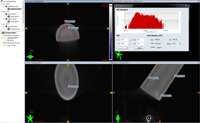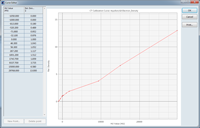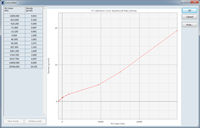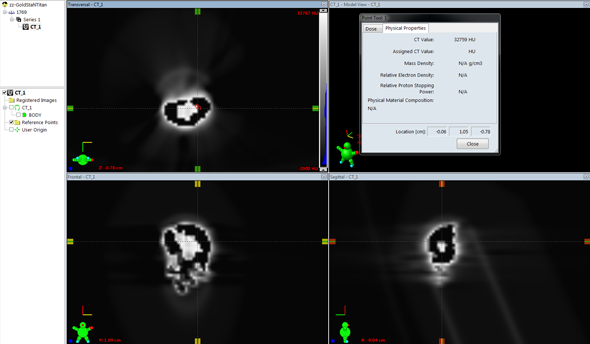CT Scanners are generally modestly accurate when it comes to high CT numbers (Hounsfield units1). For the purpose ot treatment planning, a certain high density material should ideally always give the same CT number, independent of the size of the object, the surrounding tissue, and the scanner settings. This cannot be achieved for technical reasons and due to physical limitations.
Fortunately, the volumes in the patient which contain high density materials (here we talk of Titanium and beyond) are often small. This reduces the dosimetric impact on plan quality.
Artefacts, which are the visible side effect of scanned metal objects, are often the bigger problem. If left uncorrected in the treatment planning system, they can be misinterpreted during dose calculation.
Related Posts
The topic of Electron Density and Mass Density Calibration Curves (EDens and MDens) was already discussed in several places. Some related posts are:
- Dose Behind Titanium (Jan 2015)
- HU Fidelity of the AquilionLB (May 2013)
- AcurosXB10 calculation speed (Feb 2013)
- Commissioning AcurosXB with the inhomogeneity phantom T40037 (Feb 2013)
The material Steel was already available in older Physical Materials Tables of ARIA. With ARIA 13.6, the material Gold was introduced, which is now the material with the highest density (19.32 cm3) that can be used for dose calculation.
When scanner calibration curves are extended to higher and higher values, an additional phantom is needed for routine QA of this extreme CT number range. As discussed in a recent post, it is generally a good idea to separate phantoms for the lower and the higher CT numbers, since the artefacts of high density inserts can spoil the low number measurements. As for all routine checks, the setup should be simple and setup time small.
The High Density CT Phantom
The Omega Speedmaster Professional ("Moonwatch") can be used for all kinds of things, from monitoring cooking times to saving the life of astronauts2.
The model used here (Ref. 311.62.42.30.06.001) is basically made of Titanium grade 2 (case and bracelet). Smaller components inside the watch (parts of the movement and the clasp) which are not visible from outside are made of steel. Even smaller volumes (tachymeter ring, hands and indexes) are made of an alloy3 which contains gold (>75%), copper and palladium. This combination of three materials in a small object makes the watch a perfect high density CT phantom.
The phantom was scanned on the AquilionLB with 120 kV, 16 x 0.5 mm resolution, and small Calib-FOV (240 mm). Images were reconstructed with the FC70 kernel. CT numbers were determined and compared to the reference values from the EDens and MDens calibration curves:
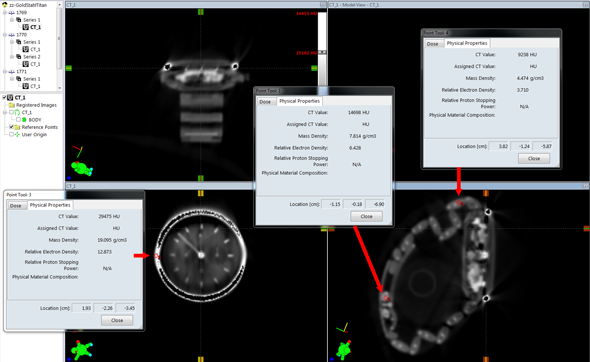
(Overview of CT numbers in a Speedy Pro, Ref. 311.62.42.30.06.001.)
The tachymeter ring shows the limits of the scanner. The X rays won't penetrate more than about 2 mm of gold, and no absorption can be computed. In the reconstructed images, the missing data is filled with -1000 HU, which gives extinction artefacts (“missing value artefacts”). The same effect can be seen with gold crowns in the patient.
A cross check was made with other phantoms that contain the same materials (they were actually used to extend our previous EDens and MDens curves, see sidebar). For gold, we used a small quantity of unused gold markers (small rods of 1 x 3 mm each) in water. They showed the same extinction artefacts beyond 32767 HU as the tachymeter ring of the Speedmaster:
The highest CT number found in this scan was 32767 HU. This means that warnings at the end of an Eclipse dose calculation like this one:
are currently (Eclipse 13.6) unavoidable, because the highest HU value that can be entered in a calibration curve is still 29768 HU:
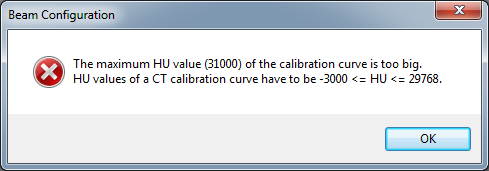
The warnings will only disappear after Varian has extended its HU scale. A product improvement request has already been filed.
Conclusion
The proposed high density CT phantom is a simple QA device for high CT numbers, in the range between Titanium and Gold. We know no other commercial phantom that can currently provide this functionality.
If used together with a conventional phantom for the lower HU range (e.g., the CIRS 062), the full CT number range of modern CT scanners can be covered.
As a side effect, one can check the scanner's clock. The scan in the first screenshot was performed at 11:52 a.m.
Notes
1From now on, we will use the following terminology: "The Hounsfield unit (HU) is the true value which the CT number should represent." (Davies 2006).
2Apollo 13 astronauts used a Speedmaster for the exact timing of one of the mid-course correction burns on their way back to earth, which helped save the mission. This has been honored by NASA with a Silver Snoopy Award.
3Omega calls this alloy Sedna™ gold.
